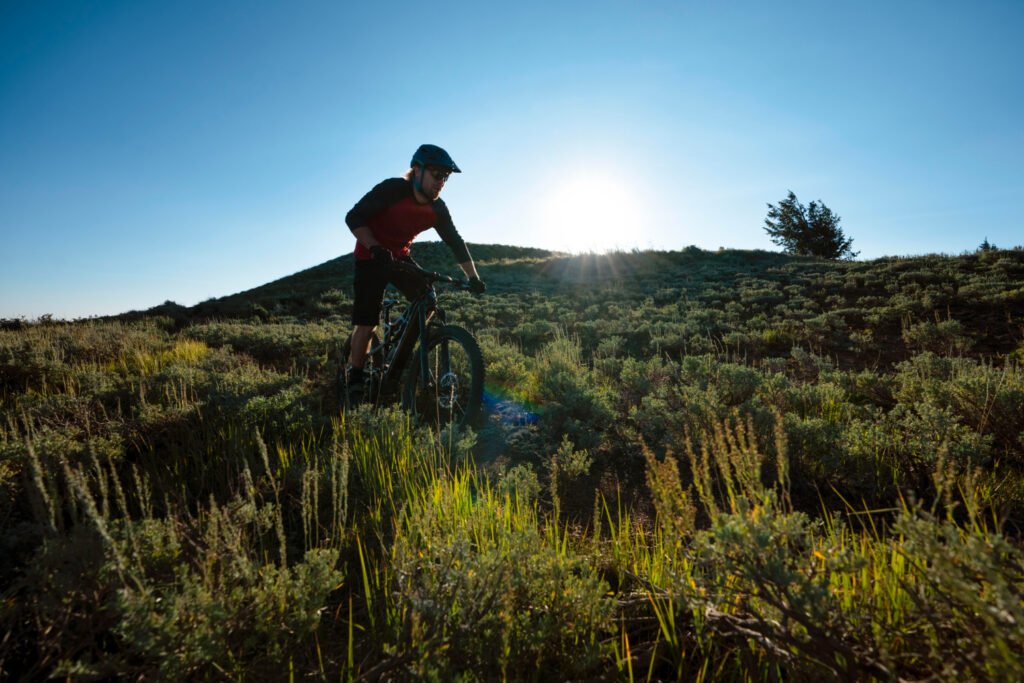The Best Fluffy Pancakes recipe you will fall in love with. Full of tips and tricks to help you make the best pancakes.
Essential MTB Tools to Carry on Every Ride
Compact, trail-ready tools every mountain biker should have.

A great mountain bike ride can quickly turn into a long hike if you’re not prepared for mechanical failures or unexpected issues. Carrying the right MTB tools and emergency supplies ensures you can fix common problems like flat tires, broken chains, or loose bolts without cutting your ride short.
From multi-tools and inflation solutions to tire repair kits and first aid, having a reliable setup means more confidence on technical trails and remote rides. In this guide, we’ll cover the must-have MTB tools every rider should pack before heading out.
For a complete overview of gear, riding skills, and safety essentials, check out our Mountain Biking Guide.
Multi-Tool with Chain Breaker for Trail Repairs
A quality multi-tool serves as the foundation of your mountain biking repair kit. Bike-specific multi-tools include essential hex keys and specialty tools for common adjustments. Chain breakers integrated into MTB multi-tools handle broken chains during remote rides.
| Tool Feature | Size Range | Primary Use |
| Allen Keys | 2-8mm | Stem, seat, brake adjustments |
| Torx Keys | T25, T30 | Disc brake rotors, chainrings |
| Screwdrivers | Flat/Phillips | Derailleur limit screws |
| Chain Breaker | Universal | Broken chain repair |
Essential multi-tool functions:
- Tighten loose stem bolts that affect steering precision during rides
- Adjust seatpost height when position shifts during mountain biking sessions
- Fix derailleur alignment issues that cause poor shifting performance
- Remove broken chain links using integrated chain breaker tools
Selection considerations:
- Choose compact designs that fit easily in jersey pockets
- Ensure tool includes your bike’s specific bolt sizes
- Look for ergonomic handles that provide good grip and leverage
- Avoid overly complex tools with rarely used features
Quality factors:
- Hardened steel construction resists wear during frequent mountain biking use
- Smooth operation of moving parts like chain breakers and folding mechanisms
A reliable MTB multi-tool handles most common trail mechanical issues efficiently.
Inflation Solutions for Trail Tire Repairs
Proper tire inflation tools ensure you can restore rolling capability after punctures. Mini pumps provide reliable inflation without consumables but require physical effort. CO₂ inflators offer quick inflation but depend on finite cartridge supplies.
Mini pump advantages:
- Reliable operation without consumable cartridges during long mountain biking adventures
- Unlimited use capability for multiple tire repairs on extended rides
- No risk of freezing hands during cold weather inflation processes
- Pressure gauge models help achieve optimal tire pressure settings
CO₂ inflator benefits:
- Rapid tire inflation gets you back on trails quickly
- Compact size fits easily in small frame bags or pockets
- Minimal physical effort required for full tire inflation
- Threaded cartridges provide controlled gas release during use
Hybrid approach recommendations:
- Carry both systems for maximum reliability during remote mountain biking
- Use CO₂ for quick repairs, mini pump for pressure adjustments
- Pack extra cartridges based on ride length and group size
- Consider pump compatibility with both Presta and Schrader valve types
| Inflation Method | Speed | Reliability | Weight |
| Mini Pump | Slow | High | Medium |
| CO₂ Inflator | Fast | Medium | Low |
| Combination | Variable | Highest | Higher |
Pressure considerations:
- Lower pressures work better for mountain biking traction and comfort
- Carry pressure gauge for consistent tire performance across different trails
Smart inflation tool selection prevents being stranded with flat tires during rides.
Complete Tire Repair Kit Essentials
Comprehensive tire repair capabilities handle various puncture scenarios during mountain biking adventures. Even tubeless tire systems occasionally require traditional repair methods for larger holes. Carrying complete repair options ensures successful trail-side tire fixes.
Core repair components:
- Quality tire levers remove stubborn tires from rim beads safely
- Spare inner tubes provide quick temporary fixes for major punctures
- Patch kits offer permanent repairs for small holes and cuts
- Tubeless plugs seal larger punctures in tubeless tire systems
Tire lever selection:
- Strong plastic or composite construction prevents rim damage during use
- Ergonomic shapes reduce hand fatigue during difficult tire removal processes
- Clip-together designs keep levers organized and prevent trail losses
- Two levers handle most tire removal situations during mountain biking
Tube and patch considerations:
- Carry tubes matching your wheel size and valve type exactly
- Patch kits work for permanent repairs when time allows
- Pre-glued patches offer convenience for quick trail-side applications
- Tubeless riders still need tubes for catastrophic tire failures
Pressure considerations:
- Lower pressures work better for mountain biking traction and comfort
- Carry pressure gauge for consistent tire performance across different trails
Smart inflation tool selection prevents being stranded with flat tires during rides.
Complete Tire Repair Kit Essentials
Comprehensive tire repair capabilities handle various puncture scenarios during mountain biking adventures. Even tubeless tire systems occasionally require traditional repair methods for larger holes. Carrying complete repair options ensures successful trail-side tire fixes.
Core repair components:
- Quality tire levers remove stubborn tires from rim beads safely
- Spare inner tubes provide quick temporary fixes for major punctures
- Patch kits offer permanent repairs for small holes and cuts
- Tubeless plugs seal larger punctures in tubeless tire systems
Tire lever selection:
- Strong plastic or composite construction prevents rim damage during use
- Ergonomic shapes reduce hand fatigue during difficult tire removal processes
- Clip-together designs keep levers organized and prevent trail losses
- Two levers handle most tire removal situations during mountain biking
Tube and patch considerations:
- Carry tubes matching your wheel size and valve type exactly
- Patch kits work for permanent repairs when time allows
- Pre-glued patches offer convenience for quick trail-side applications
- Tubeless riders still need tubes for catastrophic tire failures
| Repair Method | Speed | Permanence | Best For |
| Spare Tube | Fast | Temporary | Quick trail fix |
| Patch Kit | Slow | Permanent | Home/camp repair |
| Tubeless Plugs | Medium | Good | Tubeless punctures |
Additional repair items:
- Small knife for trimming patches or removing debris from punctures
- Tire boot material for sidewall cuts that patches cannot seal
Complete tire repair kits handle any puncture scenario encountered during mountain biking.
Chain Quick Link for Emergency Repairs
Chain failures can instantly end mountain biking adventures without proper repair tools. Master links provide reliable chain reconnection after breakage or maintenance procedures. Carrying appropriate chain links prevents long walks back to trailheads.
Master link compatibility:
- Match link speed to your drivetrain exactly (10, 11, or 12-speed systems)
- Different brands use proprietary link designs and connection methods
- Single-use links require replacement after each installation and removal cycle
- Reusable links allow multiple connections for maintenance and adjustments
Chain repair process:
- Use multi-tool chain breaker to remove damaged chain sections cleanly
- Install master link following manufacturer’s specific connection procedures carefully
- Test chain operation under light pedaling before resuming aggressive riding
- Carry spare links for multiple repairs during extended mountain biking trips
Prevention and maintenance:
- Regular chain cleaning prevents premature wear and failure rates
- Chain checker tools help determine replacement timing before trail failures
- Proper shifting technique reduces chain stress during mountain biking sessions
- Quality chains last longer and fail less frequently than budget options
Emergency alternatives:
- Zip ties can temporarily connect broken chains for emergency riding
- Removing damaged links shortens chains but maintains basic functionality
- Single-speed mode using rear derailleur fixes major shifting system failures
Compatibility considerations:
- SRAM and Shimano chains use different master link designs
- Older chains may require specific vintage master link types
- Speed-specific links ensure proper shifting performance and chain alignment
Storage recommendations:
- Keep spare master links in easily accessible pockets or tool storage
- Protect links from dirt and damage using small containers
Proper chain repair capability prevents minor mechanical issues from ending rides.
First Aid and Emergency Repair Supplies
Basic first aid and emergency repair supplies handle injuries and mechanical failures. Small medical kits treat common mountain biking injuries like cuts and scrapes. Versatile emergency items provide creative solutions for unexpected mechanical problems.
Essential first aid items:
- Antiseptic wipes clean wounds and prevent infection during trail treatment
- Adhesive bandages cover cuts and protect against further contamination
- Medical tape secures larger bandages and provides wound protection
- Pain reliever tablets help manage discomfort during long return rides
Multi-purpose emergency supplies:
- Zip ties secure broken components temporarily during emergency mountain biking repairs
- Duct tape fixes torn clothing, broken gear, and various mechanical issues
- Emergency whistle signals for help in remote trail locations
- Small LED flashlight provides visibility for repairs and navigation
Creative repair applications:
- Duct tape temporarily seals torn tire sidewalls until proper repair
- Zip ties hold broken shifters, brake levers, or derailleur hangers
- Medical tape wraps handlebar grips or secures loose cable housing
- Bandages protect skin from chafing during long mountain biking sessions
Storage and organization:
- Waterproof containers protect supplies from trail moisture and contamination
- Small pouches keep items organized and easily accessible during emergencies
- Regular inventory ensures supplies remain complete and unexpired
Group riding considerations:
- Larger groups should carry more comprehensive first aid supplies
- Designate experienced riders to carry advanced emergency equipment
- Share emergency supply weight among group members for efficiency
Proper emergency supplies provide confidence for remote mountain biking adventures safely.





